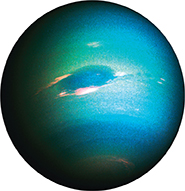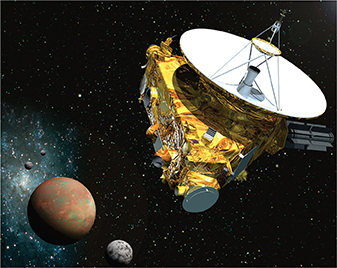Figure 25 This photo of Neptune was taken by the Voyager 2 spacecraft. The Great Dark Spot, visible near the center, was similar in size to Earth. The white clouds are thought to be made of methane ice crystals.
Formulating Hypotheses Why is the color of Neptune different from Jupiter, Saturn, and Uranus?

Figure 26 The New Horizons space probe will reach the dwarf planet Pluto and its three moons in the year 2015.

Neptune
Neptune is so far from the sun that it takes a very long time—165 Earth years—for it to make one revolution. Neptune has about the same composition and is about the same size as Uranus.
Unlike Uranus, Neptune has clearly visible cloud patterns in its atmosphere. Thin, wispy clouds form high within Neptune's atmosphere, similar to cirrus clouds in Earth's atmosphere. Earth's clouds are made of liquid water or ice crystals, but Neptune's clouds are made of methane ice crystals.
 Neptune's bluish color comes from the methane in its atmosphere.
Neptune's bluish color comes from the methane in its atmosphere.
Neptune also has large storms in its atmosphere. One of these, observed by the Voyager 2 space probe in 1989, was called the Great Dark Spot, shown in Figure 25. But by 1994, the storm was gone.
Neptune has thin rings of dark particles, very similar to the rings of Uranus. In addition, Neptune has at least 13 moons. Triton, the only large moon, has a thin atmosphere and an icy surface.
Dwarf Planets
In 2006, astronomers established a new classification for certain objects in the solar system that share some, but not all, of the characteristics of a planet. Pluto, which for many years had been considered the ninth and most distant planet in the solar system, was reclassified as a dwarf planet.  A dwarf planet, like a planet, is spherical and orbits the sun directly. But unlike a planet, a dwarf planet has not cleared the neighborhood around its orbit. In order for an object to clear out its orbit, it must be massive enough for its gravity to attract all the nearby debris. A dwarf planet is too small for this to happen. As a result, dwarf planets tend to orbit in zones that contain many other objects.
A dwarf planet, like a planet, is spherical and orbits the sun directly. But unlike a planet, a dwarf planet has not cleared the neighborhood around its orbit. In order for an object to clear out its orbit, it must be massive enough for its gravity to attract all the nearby debris. A dwarf planet is too small for this to happen. As a result, dwarf planets tend to orbit in zones that contain many other objects.
Pluto, shown in Figure 26, is much smaller than the inner or outer planets. Its diameter (2390 km) is about half that of Mercury's. The density of Pluto is similar to that of Triton, suggesting a mixture of ice and rock. Pluto's orbit around the sun is more elliptical than those of the planets. In fact, for a small portion of its orbit, Pluto actually swings closer to the sun than Neptune. Like Uranus, Pluto has a rotation axis that is tilted more than 90º. Pluto also has three moons, Charon, Nix, and Hydra.
Other known dwarf planets include Eris and the asteroid Ceres. Many more solar system objects will likely be named dwarf planets once their shapes can be verified as being spherical. Note, however, that not all astronomers agree on what defines a planet, and the classification of dwarf planet may be subjected to further debate.




